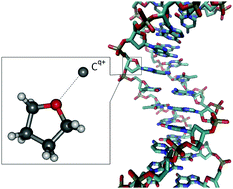Modelling charge transfer processes in C2+–tetrahydrofuran collision for ion-induced radiation damage in DNA building blocks†
Abstract
Investigations of collision-induced processes involving carbon ions and molecules of biological interest, in particular DNA building blocks, are crucial to model the effect of radiation on cells in order to improve medical treatments for cancer therapy. Using carbon ions appears to be one of the most efficient ways to increase biological effectiveness to damage cancerous cells by irradiating deep-seated tumors. Therefore, interest in accurate calculations to understand fundamental processes occurring in ion–molecule collision systems has been growing recently. In this context, the charge transfer process in the collision of C2+(1s22s2) ions with the heterocyclic sugar moiety building block tetrahydrofuran (THF) was studied in order to interpret the mechanisms occurring at the molecular level. The molecular structure properties of THF were obtained by means of ab initio quantum chemistry methods. The role of the conformational structure and the orientation of the THF molecule in collision with C2+ ions are particularly discussed. Anisotropic effects of the process dynamics in the collision energy ranging from eV to keV by means of semiclassical treatment are also presented and compared to previous experimental and theoretical investigations. A detailed analysis of the obtained cross sections points out an increase in these values by three orders of magnitude by a change of the THF symmetry from C2v to Cs in collision with C2+, which determines a more efficient charge transfer in this case.

- This article is part of the themed collection: XUV/X-ray light and fast ions for ultrafast chemistry


 Please wait while we load your content...
Please wait while we load your content...